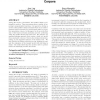Free Online Productivity Tools
i2Speak
i2Symbol
i2OCR
iTex2Img
iWeb2Print
iWeb2Shot
i2Type
iPdf2Split
iPdf2Merge
i2Bopomofo
i2Arabic
i2Style
i2Image
i2PDF
iLatex2Rtf
Sci2ools
ATAL
2009
Springer
2009
Springer
Learning a model of speaker head nods using gesture corpora
During face-to-face conversation, the speaker’s head is continually in motion. These movements serve a variety of important communicative functions. Our goal is to develop a model of the speaker’s head movements that can be used to generate head movements for virtual agents based on a gesture annotation corpora. In this paper, we focus on the first step of the head movement generation process: predicting when the speaker should use head nods. We describe our machine-learning approach that creates a head nod model from annotated corpora of face-to-face human interaction, relying on the linguistic features of the surface text. We also describe the feature selection process, training process, and the evaluation of the learned model with test data in detail. The result shows that the model is able to predict head nods with high precision and recall. Categories and Subject Descriptors I.2.6 [Artificial Intelligence]: Learning; I.2.11 [Distributed Artificial Intelligence]: Intelligen...
| Added | 26 May 2010 |
| Updated | 26 May 2010 |
| Type | Conference |
| Year | 2009 |
| Where | ATAL |
| Authors | Jina Lee, Stacy Marsella |
Comments (0)

